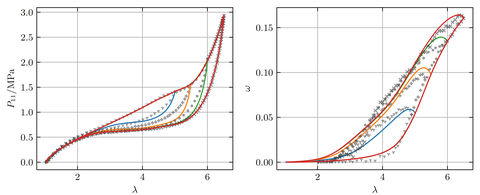Strain-induced crystallization and damage in elastomers
Elastomers based on natural rubber are used in numerous technical applications, such as tires, V-belts and medical products. As a renewable raw material, natural rubber offers ecological advantages as well as an exceptionally high mechanical strength, which is due to its ability to undergo strain-induced crystallization (SIC). Under large deformations, crystalline areas are formed which strengthen the material locally. At the same time, damage mechanisms such as cavitation, which can lead to crack formation, also play a pronounced role. The resulting interplay between strengthening and weakening mechanisms leads to complex macroscopic cracking phenomena that need to be investigated.
The aim is to develop a coupled, continuum mechanical model to describe SIC, cavitation and macroscopic crack growth under multiaxial loading. For this purpose, existing material models are extended and combined with a crack phase field model. The modeling is supported by a extensive experimental program that systematically investigates key influence factors. The parameterized model should enable the realistic simulation of experimentally observed cracking phenomena and thus contribute to the lifetime optimization of natural rubber products.
Cooperations
- Dr.-Ing. Eric Euchler, Research division elastomers, Leibniz Institute of Polymer Research Dresden (IPF)
 © TUD/NEFM
© TUD/NEFM
Dipl.-Ing. Franz Dammaß
Send encrypted email via the SecureMail portal (for TUD external users only).
Chair of Computational and Experimental Solid Mechanics
Visiting address:
Zeunerbau, Room 356 George-Bähr-Straße 3c
01069 Dresden
 © TUD/NEFM
© TUD/NEFM
Professor for Computational and Experimental Solid Mechanics
NameProf. Dr.-Ing. habil. Markus Kästner
Send encrypted email via the SecureMail portal (for TUD external users only).
Chair of Computational and Experimental Solid Mechanics
Visiting address:
Zeunerbau, Room 353 George-Bähr-Straße 3c
01069 Dresden

